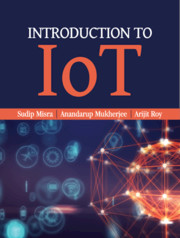Preface
Published online by Cambridge University Press: 09 January 2021
Summary
Overview and Goals
Internet of Things (IoT) is rapidly gaining a foothold in the technology sector; it has managed to emerge as a highly sought-after field of study and research in computing sciences and electronics. The vastly interdisciplinary nature of the areas to which IoT can be applied has managed to pique the interest of the whole world. IoT finds diverse use in domains spanning industrial, military, as well as regular consumer applications. The versatility of IoT and its ability to connect anything make it one of the most demanded technologies of the modern age. The involvement of people from vastly diverse and distinct backgrounds, all point to the need for a concise repository of information on this new technology.
The Internet hosts much information on IoT, which is in the form of theory, tutorials, courses, implementations, and others. However, these discussions are so scattered that even professionals in this field have trouble obtaining integrated and concise information on IoT.
IoT is a new paradigm for connecting “things” in order to automate a system. In the context of IoT, “things” include computers, cell phones, medical devices, vehicles, wearables, and other appliances and devices for daily use. These “things” tend to be heterogeneous, which results in the development and existence of a vast number of communication solutions and protocols, which vary distinctly from each other. Consequently, communications among these “things” is a challenging issue in IoT. Another major challenge in IoT is the dynamic nature of “mobile things,” which generally follow a decentralized architecture. Due to this decentralized communication and control structure, the connectivity and data transmission dynamically changes with time, in turn resulting in a new set of challenges.
Pedagogical Aids
We have included various pedagogical aids to help the reader swiftly grasp the contents and the treatment of the various topics covered in this book. We have provided a set of conceptual questions at the end of this book. For solving these questions, the reader must have completely grasped the concepts covered in this book.
Additionally, we provide visual presentations of the chapters covered in this book so that it can be used as a teaching aid in colleges and universities. Each chapter of this book has the following pedagogical components:
Learning outcomes, which gives an initial glimpse into the chapter.
- Type
- Chapter
- Information
- Introduction to IoT , pp. xxxi - xxxviPublisher: Cambridge University PressPrint publication year: 2021

